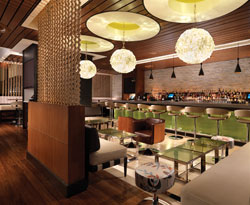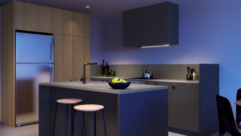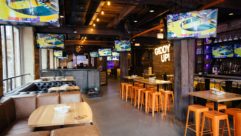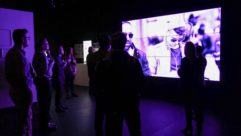

Trends in Restaurant AV
the National Restaurant Association projects that overall restaurant industry sales will increase in current dollars by 2.5 percent over 2008.
At the upscale Simon Restaurant at Palm Place in Las Vegas, the three-zoned audio system is designed to be heard and not seen. Photo: Courtesy Moser Architect Studio
Despite the fact that consumers are cutting back on spending in reaction to the current state of the U.S. economy, the restaurant industry is expected to post modest sales growth in 2009. In its recently released “2009 Restaurant Industry Forecast,” the National Restaurant Association projects that overall restaurant industry sales will increase in current dollars by 2.5 percent over 2008 (adjusted for inflation, 2009 may be down slightly).
Whatever the case, restaurants represent 4 percent of the country’s gross domestic product and employ 9 percent of its workforce.
The survey further suggests consumers are torn over their purchasing practices. On one hand, they expressed serious concern about finances, with nearly all respondents indicating that they are more worried about the economy than they were the year before.
On the other hand, 45 percent of adults said restaurants are an essential part of their lifestyle. One out of three indicated they were not eating out as often as they wished, and 35 percent said that, on a weekly basis, they were not purchasing take-out foods to go or having it delivered as often as they would like.
Nearly seven in 10 adults agreed that purchasing meals from restaurants, take-out, and delivery places made it easier for families with children to manage their daily lives, and nearly eight in 10 agreed that going out to a restaurant gave them an opportunity to socialize with friends and family.
Ronald Gorodesky, principal of the full-service consultancy Restaurant Advisory Services in Paoli, Pa., says the economy may have put a crimp in some new projects, but those restaurateurs moving forward with plans in 2009 will continue to look for contractors who can deliver a total AV experience, complete with individualized control of separate areas within the larger establishment.
That’s good news for AV systems integrators looking to add a new market or revenue stream or strengthen existing ties in an already established specialty. To be successful in this increasingly competitive market, however, more firms are upping the AV ante, offering a broader array of services to restaurant and nightclub clients. That means not only doing what you know well, but also branching out into new territory.
Trends in Restaurant AV
the National Restaurant Association projects that overall restaurant industry sales will increase in current dollars by 2.5 percent over 2008.
At Forty 1° North marina resort in Newport, R.I., more than eight independent systems are integrated into one guest relations management system.Photo: Courtesy EFS Networks
Digital Signage’s Reign Expands
On the AV front, certain things are here to stay, Gorodesky says. That includes an ongoing focus on digital signage (including implementation of interactive video displays), increased usage of flat-panel displays, multizoned audio systems, custom programming, and networked control systems to tie everything together.
“Flat screens have always been in bars, but I’m seeing owners use them a lot more in restaurants–not just in the bar part of the establishment but in the dining rooms,” Gorodesky says.
According to last year’s industry forecast by the National Restaurant Association, more than half of full-service restaurant operators surveyed offer TVs in their operations, and at least four in 10 see TVs becoming increasingly popular in restaurants in the future. On the consumer side, nearly three in 10 consumers surveyed said they would be likely to watch a small, at-table television if their favorite restaurant offered it. Most often, digital signage is used to display menus, table seating announcements, or advertising.
Digital video menu boards are another way restaurants–especially those in the quick-service or fast food segment–can improve operational efficiency and distinguish themselves from the competition. In fact, 14 percent of quick-service operators surveyed said they currently offer digital/video menu boards. In addition, 83 percent of operators said they believe these devices will become more popular in the quick-service segment in the future.
Blended AV and IT
“These days, restaurant and bar clients want more control over their audio and video,” Gorodesky says. “They want to be able to run video with audio at different volumes and be able to move things around to accommodate the desires of private parties or special requests from customers.”
Maria Cody, senior director for AVI-SPL working primarily in Las Vegas, agrees. She continues to see the standard multizoned audio setups in restaurants and notes that IT is playing a greater role in the design of these venues as well. Digital processing demands continue to increase the complexity of AV installations.
“More and more, these clients want to have the systems right on the backbone of the Ethernet,” she says. “Because AV is almost an afterthought in many installations, we’re trying to change that. By bringing AV earlier into the design process, customers will have a clearer idea of what they need, especially with all of the information-sharing considerations.”
In addition to the ongoing adoption of digital signage and zoned AV, Gorodesky has noticed a somewhat new arrangement emerging–the birth of what he calls the “technology integrator” specialist.
“These are the guys who come in and take care of your phone, audio, video, security systems, surveillance, Internet, and point-of-sale–not just your AV–and coordinate everything from start to finish,” he says. “That’s a relatively new concept compared to the traditional systems integrator.”
Exclusively targeting the hospitality market, EFS Networks in Philadelphia offers a hybrid of services to restaurant and bar clients, including IT general contracting and project management, technology budget planning, architectural planning and drawings for technology structured wiring and layout, and electrical planning/budget negotiation with the electrical trade.
Like Gorodesky, EFS CEO Evan Solomon believes future success in this niche hinges on a contractor’s ability to handle multiple facets of technology.
“Our typical customers are those embarking on a hospitality development project and are quickly overwhelmed with untangling all of the decisions regarding adoption of technology,” says Solomon. “Restaurants, bars, and hotels of any shape or size can use technology strategically–not just to take a reservation or play some background music. It’s all a matter of how the design and implementation wrap around the vision and operations of the establishment, which a single vendor selling a single system doesn’t take into account.”
Although his firm performs much of the work itself–including IT infrastructure, wireless and network systems, phones, point-of-sale, e-commerce systems, Web design, and integration of guest management systems–Solomon has also established a network of reliable subcontractors, consultants, and industry partnerships (including AV consultants and installers) to handle components such as audio and video systems, burglar alarms, security card access, fire panels, and security cameras/CCTV.
EFS takes the lead role of project manager and design consultant, with installation assistance provided by business partners or subcontractors. Its AV projects have ranged from traditional background music systems to distributed audio and video systems, says Solomon, including what he calls “buffet of service” systems for private event and meeting spaces.
A good example of this concept is the newly constructed Forty 1° North marina resort in Newport, R.I. EFS integrated more than eight independent systems into one seamless electronic guest relations management system. A single guest card provides access to the facility and all of its amenities, serves as a house account in all revenue facilities (including the marina and Grill Restaurant), and tracks rewards points. On the back-end, the integrated guest program systems provide automatic billing of house charges and offers owners strategic information about guest preferences.
“As the hospitality industry profits greatly from private event sales–creating a buffet of AV and IT services that a restaurant can offer to clients allows the up-selling of these technology items just as [restaurants] sell an extra hot appetizer station or an upgraded liquor package for an event,” says Solomon. “If a restaurant space can adapt to multiple event and use configurations, so must the audio, video, point-of-sale, and all other involved technology components.”
Solomon maintains that a trend toward designing portable AV and IT components is the future of restaurant/bar installations in order to ensure such functionality can be sold like any other item on the menu. Examples of the buffet of services might includf: flexible distribution of music and video for all possible event configurations (including multiple input and output configurations); AV input and output panels strategically located in multiple event space zones, and open conduit pipes from front-of-house to back-of-house for future expansion or one-time event use; conference bridge lines and videoconferencing; distribution of customer audio and video; and a technology concierge–a dedicated resource for streamlining setup, tear down, support, and delivery of services for an event.
Although not always executed to this extent, Solomon says this concept is being embraced by restaurateurs on simpler projects, all looking for some degree of flexibility and portability in their AV systems.
Trends in Restaurant AV
the National Restaurant Association projects that overall restaurant industry sales will increase in current dollars by 2.5 percent over 2008.
Multifunctional Zones
Troy Moser, principal architect with Moser Architecture Studio in Las Vegas, has noticed a similar need for AV flexibility in his designs, which include Prive Nightclub in the Planet Hollywood Hotel and Casino, Studio 54 at the MGM Grand, and the Simon Restaurant at Palms Place. At least in the Vegas market, he’s seen a shift from a mega club concept to a compartmentalized approach in nightclub design, with owners increasingly wanting to break the building down into smaller, more intimate spaces.
“You’ve always had your VIP rooms, but the ‘ultra lounge’ has become sort of a buzzword in club design in Vegas these days,” says Moser. “That’s where you take the intimacy of a smaller bar-like atmosphere and combine it with the energy level of a nightclub.”
This approach typically incorporates the ability to accommodate a traveling DJ. “The club crowd seems to want celebrity DJs, so the nightclubs have to make it happen,” he says. “In this situation, you’ve not only got audio and video feeds, but you also have to create sort of an isolated turntable situation, which can be very structurally complicated AV-wise. At the same time, the owner will inevitably want multiple audio zones to satisfy different types of customers.”
In the case of the Simon Restaurant, one of his most recent restaurant projects, Moser says the owner settled on three different distinct audio zones to create a different mood and feel within the restaurant, including the main dining room with a sushi bar, a bar/lounge area, and a garden room.
“We designed an infrastructure that also made a guest DJ possible, in case they wanted that capability for special events or parties,” he says. “Otherwise, it was a very finished sort of upscale restaurant where AV is to be heard and not seen.”
As with many clients Moser has worked with in the past, the Palms Resort brought in its own preferred list of consultants and suppliers from day one, including AV people to do their own specifications, design, and installation. This type of AV firm, which is resembles Solomon’s EFS Networks, can handle as little or as much as the client wants, Moser explains.
“This might include everything from AV to security to computer systems,” he says. “They’ll go as far as not only designing the points of connection and backbone, but also specing the equipment and doing the installation if you so desire.”
Despite the fact that the restaurant/nightclub market is vast, many systems integrators, including large firms, choose not to join the ranks of specialists like Solomon. However, that could be changing, as the economic downturn and competition force contractors to journey outside of their comfort zone and take a renewed look at alternative verticals.
Keeping an open mind can also open new doors in unexpected places, says AVI-SPL’s Cody. “I think a lot of integrators shy away from restaurants because they think there’s not a lot of profit in them,” she says. “What they need to remember is how you get into the market. If you have a relationship with the owner, it makes a big difference. Word of mouth is huge in this business. We look at it not so much as a profit center but as a relationship builder. Yes, this particular client does restaurants, but what else do they do? And who else do they know?”
Ellen Parson is a contributing editor to Pro AV.
Trends in Restaurant AV
the National Restaurant Association projects that overall restaurant industry sales will increase in current dollars by 2.5 percent over 2008.
Photo: Courtesy Soundvision Systems
AV Helps Sports Bar Sport Family Feel
Sports bars aren’t just for adults anymore, at least that’s the concept many restaurateurs are adopting when launching new establishments. More frequently, owners are trading traditional restaurant templates for separate multifunctional spaces that incorporate individual themes. Combining indoor dining spaces with bar/lounge areas and outdoor eateries, a new breed of restaurants is striving to appeal to customers of all ages. And using cutting-edge AV systems in the process draws them in and keeps them coming back.
The new Bru’s Room in Coconut Creek, Fla., the brainchild of Miami Dolphins linebacker Bob “Bru” Brudzinski and his partner, Wings ‘N Things founder Eddie Hauk, is the perfect case in point. This upscale 20,000-square-foot facility boasts five different rooms–a family dining area, outdoor covered dock, patio bar, kids ice cream parlor, and private lounge–each outfitted with state-of-the-art audio and video systems designed by Coral Springs, Fla.-based SoundVision Systems.
The high-powered sound system in the main areas is centered around Community VERIS 3594 and 3294 loudspeakers, with the bottom end handled by Community SONUS 18-inch subwoofers. The outdoor lounge is served by four of Community’s R.5 all-weather models, while Cloud6 ceiling speakers cover the dining areas. The system is powered by Lab.gruppen and Samson amplification, with DSP and zoning handled by nine Biamp SPM412e controllers.
“Good sound was a priority for these guys–not just loud, but well focused,” says SoundVision’s Ron Adams. “It was important to be able to fill the area with club-quality sound, but not blast out the bartenders or the customers.”
More than 80 video displays provide non-stop action virtually everywhere in the club, with 30 DirecTV HD receivers networked via Cat-5. The main restaurant area is outfitted with an 18-foot Sanyo projector system, as well as 24 Panasonic 58-inch plasma screens. The same setup graces the outdoor patio area. In the kids’ room, three 55-inch Hitachi plasma displays keep the youngsters busy, while parents can watch them courtesy of several CCTV cameras. Even the restrooms are covered by 23-inch LCD displays.
“These guys really went the extra mile in putting together a top-notch environment,” says Adams. “It’s not just a boys’ club kind of place; it’s the kind of place you can bring the whole family. It’s really the only place of its kind.”










